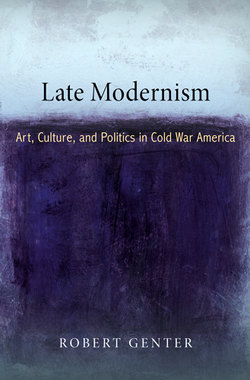Late Modernism

Реклама. ООО «ЛитРес», ИНН: 7719571260.
Оглавление
Robert Genter. Late Modernism
Отрывок из книги
LATE MODERNISM
Casey Nelson Blake, Series Editor
.....
In January 1962 the Saturday Evening Post ran a front-page cover painted by Norman Rockwell, the popular commercial illustrator and artist. The image featured a wealthy-looking art collector, umbrella and hat in hand, intently pondering a large abstract canvas, unaware that Rockwell had made him the focus of attention. The editors of the magazine joined Rockwell in his playful joke, asking whether the man was “about to reach for his checkbook to buy a prize-winning work titled ‘The Insubstance of Infinity’” or whether he was “imagining his teen-age daughter calling it ‘Strictly from Blobsville.’”74 Rockwell continued the joke in describing his experimentation with the Pollockesque-style canvas on the cover. According to Rockwell, he had recently attended a class in modern art techniques where he “learned a lot and loved it,” although he did eventually tire of “waving a dripping brush” and had to invite the man painting the windows in his studio to help finish it. Sarcasm aside, Rockwell’s commentary reflected the astounding success high modernism achieved in the 1940s and 1950s. Several legendary moments marked the ascendancy of high modernism. In 1944 director Alfred Barr facilitated the acquisition of Jackson Pollock’s She-Wolf by the Museum of Modern Art, giving institutional recognition to the abstract expressionist movement and paving the way for the escalating “Pollock market” after the painter’s untimely death.75 The “picture boom,” as Art News described, that followed the favorable economic climate after the war also advanced the cause of modern art.76 In 1949, William Faulkner, praised for his insights into the psychological landscape of the human mind, was awarded the Nobel Prize in literature, helping to advance the reputation of the aging modernist writer. Similarly, despite considerable debate because of his political leanings, Ezra Pound won the Bollingen Prize in poetry that same year. In 1956 T. S. Eliot, whom Delmore Schwartz acknowledged as having his own “literary dictatorship,” famously lectured to a crowd in Minneapolis, equaling, according to one account, “that of three hockey games.”77 Finally, in the most public moment of recognition, poet Robert Frost and abstract artist Mark Rothko were invited to the inauguration of John F. Kennedy in 1960, standing beside politicians, celebrities, and sports figures as representatives of American culture.
Despite such public exposure, appearing in photographs on the pages of countless mass-circulation magazines, high modernists recognized that their true cultural project rested elsewhere. The problem of modernism in the postwar era, as David Hollinger has argued, was neither a problem of authorship nor even of critical attention but a problem of readership.78 Although experimental literary works were still in production and abstract paintings were filling gallery walls, the task in the 1940s was to promote modernism by gaining new financial support for artists and writers after the end of New Deal–sponsored federal subsidies, developing an educational curriculum to consolidate reading practices, and carving out avenues to translate modernist forms to an educated public. In 1946 Clement Greenberg, for instance, was troubled that “there exists in this country no self-assured, self-intelligible class of connoisseurs and amateurs of art with defined and independent tastes.”79 Culture required cultivation, literary education required educators, abstract painting needed gallery space and promotional support, and poetic production depended upon publishers and sales. Therefore, despite the seemingly ever-present elitism of high modernist rhetoric, many critics made deliberate efforts to carve out an intellectual milieu for modernist works. In his contribution to the 1952 Partisan Review symposium “Our Country and Our Culture,” Lionel Trilling, for instance, encouraged the growth of a “new intellectual class” to counter the erosion of public tastes, and he asked his fellow men of letters to help “in the continuation of the traditional culture in the traditional forms.”80 Along with Jacques Barzun and W. H. Auden, Trilling served as a literary consultant for two book clubs, the Reader’s Subscription and the Mid-Century Book Society, and wrote a number of introductions for the selected works.81 Other high modernists, including many New York intellectuals, also took seriously this responsibility. Philip Rahv wrote several introductions to rereleases of works by Henry James, Franz Kafka, and Leo Tolstoy for Dial Press and the Modern Library, and William Phillips engaged in a similar project for English translations of the work of Fyodor Dostoevsky. Many other modernists including Allen Tate, Irving Howe, and Robert Penn Warren worked with major commercial publishers such as Henry Holt and Prentice Hall to publish collected volumes of writings by modernist writers. Likewise, Cleanth Brooks coedited four famous textbooks of literary criticism (Understanding Poetry, Understanding Fiction, Understanding Drama, and An Approach to Literature), and the success of those collections prompted countless other modernist critics to publish similar volumes, including the ubiquitous Norton Anthology collections. The most noteworthy pedagogical effort to introduce high modernism to a broad audience occurred in a series of “Round Table” discussions in the pages of Life magazine.82 Appropriating the idea from Fortune magazine, which had held a series of public discussions in the 1930s concerning the international economic situation, the editors of Life, under the instruction of Henry Luce himself, routinely gathered prominent intellectuals to discuss the state of American culture. The most famous was the 1948 “Life Round Table on Modern Art,” featuring “fifteen distinguished critics and connoisseurs,” including Meyer Schapiro, Clement Greenberg, Alfred Frankfurter, and H. W. Janson, all of whom attempted to translate high modernist art into an accessible vernacular. In fact, moderator Russell Davenport offered a suggestion on the problem of the “esthetic experience,” telling the confused Life reader that when confronting a piece of abstract art “he should look devotedly at the picture, rather than at himself, or at any aspect of his environment,” language borrowed directly from Clement Greenberg.83
.....